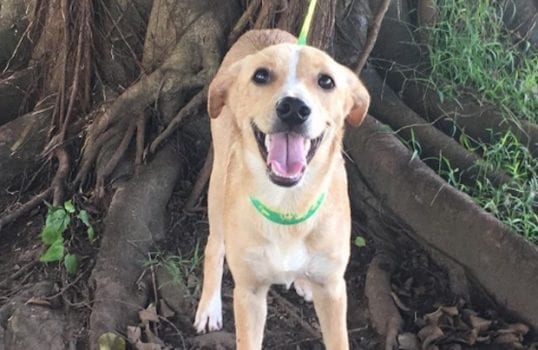Heading out to the beach, especially in a tropical paradise such as Puerto Rico, is typically an exciting and fun adventure. However, for thousands of dogs in the municipality of Yabucoa, on the southeastern coast, it is where they go to die. The beach at the end of a lonely road is so notorious for dumping dogs, the locals dubbed it “dead dog beach.”
For over ten years, Chrissy Beckles, founder and president of The Sato Project, has been caring for these dogs. The lucky ones are rescued and provided full veterinary care before being flown to waiting foster and forever homes on the along the East Coast of the United States.
“The municipality of Yabucoa is the poorest on the island, but there is a huge stray dog problem all over,” Beckles says. “There’s an estimated 500,000 stray dogs wandering an island roughly the size of Connecticut.”
Beckles and her volunteers are making progress, but it’s been a long road and there is much more to do to help the dogs, even the ones brought to shelters in the area.
“Going into one of the five shelters there is almost an automatic death sentence,” Beckles says. “They have a 99 percent kill rate because there are just so many animals.”
An Overwhelming Number of Dogs
Beckles’ husband is a stunt man who was working on a movie in Puerto Rico when she decided to accompany him on the trip.

“A friend of mine told me I was going to freak out when I saw the number of strays running around,” Beckles says. “It was overwhelming, I spent one week feeding strays and taking them to the vet.”
When Beckles returned home, she began contacting rescues to see what she could do to help. She found a rescue that was working with the dogs on dead dog beach and began volunteering, traveling back and forth from her home in New York, where she was a self- employed consultant.
After over two years, Beckles said the other woman suffered from rescue fatigue and asked her to take over.
“She really didn’t have a good support system,” Beckles says. “I ran her rescue for a while, but decided I wanted a fresh start.”
In 2011, Beckles founded The Sato Project. The word “sato” is slang in Puerto Rico for stray dog. “It’s not an endearing term, but I wanted to educate people and change the perception,” she says.
One of the catalysts for Beckles to found The Sato Project was Boom Boom, a beautiful mixed breed Beckles rescued as a puppy in 2009 from the Arecibo municipal shelter in Puerto Rico. Boom Boom was only five weeks old when she was dumped at the shelter with her mother and littermates and was the only one to make it out of the shelter alive.
“She was the greatest foster sister, she would pout for a couple of hours when a new dog came to our house, but after a couple of hours, she would come around and play and teach them,” she says. “It was if she was telling them everything would be okay. She was very special.”
Moving The Sato Project Forward
Beckles built her volunteers to approximately ten people in Puerto Rico. At first, the mission was to concentrate efforts on dead dog beach. The group makes sure the dogs here have food and water and, if they need medical care, they are taken to a veterinarian. Every dog who enters The Sato Project program receives veterinary care, vaccines, microchip and spay or neuter. Since they began, Beckles says the organization has taken 1,500 dogs from the beach.

Beckles says the vetting and foster process typically takes six to eight weeks, but oftentimes it is longer, as 80 percent of the dogs suffer from parasites, heartworms, mange and other skin afflictions. Once they are vetted and receive health certificates for travel, they are flown to JFK airport, where a team of core volunteers takes them to foster homes while they await their forever adoptive homes.
The adoption fee for a dog through the rescue is $400 and the organization spends an average of $1,000 on each dog just getting them healthy. The Sato Project once spent $20,000 on a dog named Sugar who had to have extensive surgeries after being hit with a car.
“We lose money on each dog, but it’s so worth it,” says Beckles, who long ago gave up her consulting business to work in rescue full time and only started taking a small salary last year.
Margee Krokulski and her husband, Paul Moreno, adopted Francesco, a shepherd mix who was found on dead dog beach. Francesco was so plagued with mange and malnutrition that rescue volunteers didn’t think he would survive.
“We thought he was a lot older because he was in such poor condition,” says Beckles. “His paws were so swollen that he could barely walk and when we first placed him on an IV, he just laid there and moaned.”
It took months, but Francesco (now Frankie) made a miraculous recovery. Beckles says they were surprised to learn Frankie was only about a year old and that someone had taken the time to teach him basic training commands before dumping him on the beach.

“I saw The Sato Project on television and never really thought of dogs in Puerto Rico,” says Krokulski. “I went to their website and just fell in love with Frankie.”
He is now a beautiful, healthy and happy dog living with his two humans and a canine sister named Sadie.
Making Changes in Puerto Rico
Beckles worked with officials and, in 2015, gates were put up along dead dog beach that are locked at night, limiting the ability to dump dogs. There are also security cameras monitored by authorities.
The Sato Project has also begun offering low-cost vaccine, microchip and spay/neuter clinics to pet owners in Puerto Rico, as well as passing out 45 vouchers per month to pet owners so they can seek those services outside of the clinics. Beckles says that through these efforts, about 600 more dogs have been helped.
When Boom Boom passed away from pancreatitis last year, Beckles said it almost ruined her.
“I really didn’t think I would be able to continue in rescue,” she says.

Instead of giving up, she turned her grief into action and created Operation Boom Boom, raising $54,000 to assist in renovating the shelter where Boom Boom was adopted. The organization has also began rescuing dogs from that shelter and so far over 115 dogs have been rescued from certain death. Their goal is to visit the shelter at least once a month and rescue dogs who are older or have health issues.
Additionally, Beckles plans to expand their trap-neuter-return program, which partners with another woman on the island who maintains a pack of about 30 dogs.
“Some dogs just aren’t candidates for rescue, but we can still help them by feeding and providing veterinary care,” says Beckles.
Beckles not only works in Puerto Rico to help change the perception of unwanted dogs, but also in the U.S. It appears that her efforts of changing the meaning of “sato” from a negative to a positive are paying off, as The Sato Project has had dogs in the Puppy Bowl for several years (Panda and Basher were the organization’s representatives this year).
“It’s a great effort and does so much to elevate and change perception of adoption,” she says.
Images via Sato Project Facebook page.
Kerri Fivecoat-Campbell is a freelance journalist and author who lives in a tiny house with her 5 dogs and husband.
Share:









